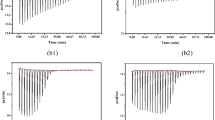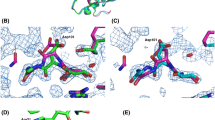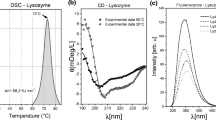Abstract
Acid unfolding pathway of conalbumin (CA), a monomeric glycoprotein from hen egg white, has been investigated using far- and near-UV CD spectroscopy, intrinsic fluorescence emission, extrinsic fluorescence probe 1-anilino-8-napthalene sulfonate (ANS) and dynamic light scattering (DLS). We observe pH-dependent changes in secondary and tertiary structure of CA. It has native-like α-helical secondary structure at pH 4.0 but loss structure at pH 3.0. The CA existed exclusively as a pre-molten globule state and molten globule state in solution at pH 4.0 and pH 3.0, respectively. The effect of pH on the conformation and thermostability of CA points toward its heat resistance at neutral pH. DLS results show that MG state existed as compact form in aqueous solutions with hydrodynamic radii of 4.7 nm. Quenching of tryptophan fluorescence by acrylamide further confirmed the accumulation of an intermediate state, partly unfolded, in-between native and unfolded states.








Similar content being viewed by others
Abbreviations
- ANS:
-
1-anilino-8-napthalene sulfonate
- CA:
-
Conalbumin
- DLS:
-
Dynamic light scattering
- GnHCl:
-
Guanidine hydrochloride
- MG:
-
Molten globule
- MRE:
-
Mean residue ellipticity
- P d :
-
Polydispersity
- T m :
-
Mid-point temperature
References
Ptitsyn, O. B., Pain, R. H., Semisotnov, G. V., Zerovnik, E., & Razgulyaev, O. I. (1990). Evidence for a molten globule state as a general intermediate in protein folding. FEBS Letters, 262, 20–24.
Arai, M., Ito, K., Inobe, T., Nakao, M., Maki, K., Kamagata, K., et al. (2002). Fast compaction of alpha-lactalbumin during folding studied by stopped-flow X-ray scattering. Journal of Molecular Biology, 321, 121–132.
Hsieh, H. C., Kumar, T. K., Chiu, C. C., & Yu, C. (2005). Equilibrium unfolding of an oligomeric protein involves formation of a multimeric intermediate state(s). Biochemical and Biophysical Research Communications, 326, 108–114.
Sridevi, K., Lakshmikanth, G. S., Krishnamoorthy, G., & Udgaonkar, J. B. (2004). Increasing stability reduces conformational heterogeneity in a protein folding intermediate ensemble. Journal of Molecular Biology, 337, 699–711.
Nishimura, C., Dyson, H. J., & Wright, P. E. (2008). The kinetic and equilibrium molten globule intermediates of apoleghemoglobin differ in structure. Journal of Molecular Biology, 378, 715–725.
Paci, E., Greene, L. H., Jones, R. M., & Smith, L. J. (2005). Characterization of the molten globule state of retinol-binding protein using a molecular dynamics simulation approach. FEBS Journal, 272, 4826–4838.
Chen, B. L., Baase, W. A., Nicholson, H., & Schellman, J. A. (1992). Folding kinetics of T4 lysozyme and nine mutants at 12°C. Biochemistry, 31, 1464–1476.
Nakao, M., Maki, K., Arai, M., Koshiba, T., Nitta, K., & Kuwajima, K. (2005). Characterization of kinetic folding intermediates of recombinant canine milk lysozyme by stopped-flow circular dichroism. Biochemistry, 44, 6685–6692.
de Sousa Rde, C., Coimbra, J. S., da Silva, L. H., da Silva, Mdo. C., Rojas, E. E., & Vicente, A. A. (2009). Thermodynamic studies of partitioning behavior of lysozyme and conalbumin in aqueous two-phase systems. Journal of Chromatography B, 877, 2579–2584.
Stevens, L. (1996). Egg proteins: What are their functions? Science Progress, 79, 65–87.
Ko, K. Y., Mendonca, A. F., & Ahn, D. U. (2008). Influence of zinc, sodium bicarbonate, and citric acid on the antibacterial activity of ovotransferrin against Escherichia coli O157:H7 and Listeria monocytogenes in model systems and Ham. Poultry Science, 87, 2660–2670.
Stevens, L. (1991). Egg white proteins. Comparative Biochemistry and Physiology B, 100, 1–9.
Kelly, S. M., & Price, N. C. (2000). The use of circular dichroism in the investigation of protein structure and function. Current Protein & Peptide Science, 1, 349–384.
Woodworth, R. C., & Schade, A. L. (1959). Conalbumin: a rapid, high-yield preparation from egg white. Archives of Biochemistry and Biophysics, 82, 78–82.
Chen, Y. H., Yang, J. T., & Martinez, H. M. (1972). Determination of the secondary structures of proteins by circular dichroism and optical rotatory dispersion. Biochemistry, 11, 4120–4131.
Pace, C. N., & Scholtz, M. (1997). Protein Structure, A Practical Approach. In T. E. Creighton (Ed.), Measuring the conformational stability of a protein (p. 383). New York: Oxford University Press.
Ahmad, E., Rahman, S. K., Khan, J. M., Varshney, A., & Khan, R. H. (2010). Phytolacca americana lectin (Pa-2; pokeweed mitogen): An intrinsically unordered protein and its conversion into partial order at low pH. Bioscience Reports, 30, 125–134.
Larsson, T., Wedborg, M., & Turner, D. (2007). Correction of inner-filter effect in fluorescence excitation-emission matrix spectrometry using Raman scatter. Analytica Chimica Acta, 2, 357–363.
Venyaminov, S. Y., & Yang, J. T. (1996). In G. D. Fasman (Ed.), Circular dichroism and the conformational analysis of biomolecules (pp. 69–109). New York: Plenum Press.
Kelly, S. M., & Price, N. C. (1997). The application of circular dichroism to studies of protein folding and unfolding. Biochimica et Biophysica Acta, 1338, 161–185.
Varshney, A., Ahmad, B., Rabbani, G., Kumar, V., Yadav, S., & Khan, R. H. (2010). Acid-induced unfolding of didecameric keyhole limpet hemocyanin: detection and characterizations of decameric and tetrameric intermediate states. Amino Acids, 39, 899–910.
Ahmad, E., Fatima, S., Khan, M. M., & Khan, R. H. (2010). More stable structure of wheat germ lipase at low pH than its native state. Biochimie, 92, 885–893.
Rossi, M., & Schiraldi, A. (1992). Thermal denaturation and aggregation of egg proteins. Thermochimica Acta, 199, 115–123.
Eftink, M. R., & Ghiron, C. A. (1987). Does the fluorescence quencher acrylamide bind to proteins? Biochimica et Biophysica Acta, 3, 343–349.
Hanakam, F., Gerisch, G., Lotz, S., Alt, T., & Seelig, A. (1996). Binding of hisactophilin I and II to lipid membranes is controlled by a pH-dependent myristoyl-histidine switch. Biochemistry, 35, 11036–11044.
Grimsley, G. R., Shaw, K. L., Fee, L. R., Alston, R. W., Huyghues-Despointes, B. M., Thurlkill, R. L., et al. (1999). Increasing protein stability by altering long-range coulombic interactions. Protein Science, 8, 1843–1849.
Fink, A. L., Calciano, L. J., Goto, Y., Kurotsu, T., & Palleros, D. R. (1994). Classification of acid denaturation of proteins: Intermediates and unfolded states. Biochemistry, 33, 12504–12511.
Pace, C. N., Alston, R. W., & Shaw, K. L. (2000). Charge-charge interactions influence the denatured state ensemble and contribute to protein stability. Protein Science, 9, 1395–1398.
Sheshadri, S., Lingaraju, G. M., & Varadarajan, R. (1999). Denaturant mediated unfolding of both native and molten globule states of maltose binding protein are accompanied by large delta Cp’s. Protein Science, 8, 1689–1695.
Acknowledgments
This work was supported by the Council of Scientific and Industrial Research (CSIR) funded project New Delhi, India grant No. 37(1456)/10/EMR-II. G. Rabbani acknowledged CSIR, New Delhi, India for financial assistance in the form of Senior Research Fellow (SRF). A. H. Khan, University of Glasgow, Scotland is greatly acknowledged for the editing and valuable suggestions during the preparation of this manuscript.
Author information
Authors and Affiliations
Corresponding author
Rights and permissions
About this article
Cite this article
Rabbani, G., Ahmad, E., Zaidi, N. et al. pH-Dependent Conformational Transitions in Conalbumin (Ovotransferrin), a Metalloproteinase from Hen Egg White. Cell Biochem Biophys 61, 551–560 (2011). https://doi.org/10.1007/s12013-011-9237-x
Published:
Issue Date:
DOI: https://doi.org/10.1007/s12013-011-9237-x




